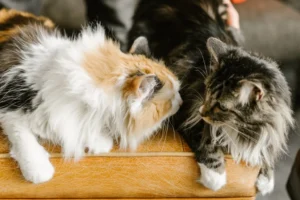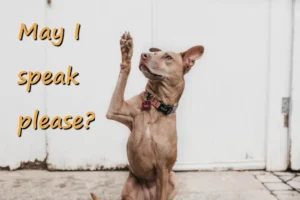Cats and dogs: a classic rivalry that has puzzled pet owners for centuries. While dogs may seem eager to make friends with their feline counterparts, cats can often be found instigating playful (or not so playful) interactions with dogs. But why do cats mess with dogs? Let’s unravel this age-old mystery.
Dogs and cats have different communication styles, leading to misunderstandings and potential conflict. Cats may see dogs as intruders in their territory, leading them to assert dominance or simply engage in playful antics. Understanding the underlying reasons for this behavior can help pet owners foster better relationships between their furry companions.
Sensory Differences: Why do cats mess with dogs?
Cats and dogs may seem like they speak different languages, but it’s actually all about how they see the world around them. Cats rely heavily on their keen sense of smell and excellent night vision to navigate their surroundings, while dogs depend more on their acute hearing and strong sense of hearing.
This difference in sensory perception can sometimes lead to misunderstandings. For example, a curious cat might approach a dog to investigate a new smell, not realizing that the dog may interpret this as a threat. Similarly, a playful dog may bark excitedly, unaware that the loud noise could startle a sensitive cat.
Understanding these sensory variations can help pet owners create a harmonious environment for their furry friends. Providing separate spaces for cats and dogs to retreat to when they need some alone time can prevent unnecessary conflicts and promote peace in the household.
Social Hierarchy: What role does dominance play in cat-dog interactions?
When it comes to cat-dog interactions, dominance can often be at the heart of the matter. While cats are known for their independent and sometimes aloof nature, they can also have a strong need to establish dominance within their living space. This can lead to them testing boundaries with dogs, especially if they perceive the dog as a threat to their territory.
In a shared household, it’s important for pet owners to establish clear boundaries and provide equal attention to both their feline and canine companions. This can help prevent power struggles and reduce the likelihood of conflicts between the two animals.
Additionally, incorporating regular play sessions and providing mental stimulation for both cats and dogs can help channel their energy in a positive way. By fostering a balanced environment where both animals feel secure and respected, pet owners can help promote a peaceful coexistence between their pets.
- Provide vertical spaces for cats to climb and observe their surroundings.
- Use positive reinforcement training techniques to encourage good behavior in both cats and dogs.
- Consider consulting with a professional animal behaviorist if cat-dog conflicts persist despite your best efforts.
Remember, a little understanding and patience can go a long way in fostering a harmonious relationship between your cat and dog.
Play Behavior: How do cats view playtime with dogs?
When it comes to playtime, cats and dogs have different ways of viewing it. Cats often see playtime with dogs as a way to establish boundaries and assert their dominance. By engaging in play behavior, cats can communicate their limits and preferences to dogs, ensuring a harmonious relationship. Playful interactions between cats and dogs can involve chasing, swatting, and pouncing, all in good fun but also serving a purpose in establishing boundaries.
Body Language: What cues do cats and dogs give each other during interactions?
Body language is key when it comes to interactions between cats and dogs. Cats may use subtle cues like tail flicking or ear flattening to communicate their feelings and intentions to dogs. On the other hand, dogs may offer play bows or wagging tails as signs of friendliness and eagerness to engage. Understanding these nonverbal signals is crucial for ensuring a positive and respectful relationship between cats and dogs.
Additional Insight:
Here are some common body language cues that cats and dogs may use during interactions:
- Tail position: A high, twitching tail on a cat may indicate agitation, while a low, slowly swishing tail could signal relaxation.
- Ears: Pinned-back ears on a cat may show fear or aggression, while forward-facing ears could indicate curiosity or excitement.
- Direct eye contact: Both cats and dogs may interpret direct eye contact as a challenge or threat, so it’s best to avoid prolonged stares during interactions.
Remember, paying attention to these subtle cues can help foster a harmonious relationship between your furry friends.
Environmental Factors: How does the home environment impact cat-dog relationships?
When it comes to understanding why cats mess with dogs, the home environment plays a crucial role. Cats are territorial animals who may feel threatened by the presence of a dog in the household. Providing separate spaces for each pet can help reduce tension. Cats also require vertical space to feel safe, so consider installing cat trees or shelves for them to climb on. Additionally, ensuring each pet has access to their own resources like food, water, and litter boxes can prevent conflicts over sharing.
Training Strategies: How can pet owners help cats and dogs coexist peacefully?
Training both cats and dogs can significantly improve their relationship. For dogs, teach them to respect the cat’s space and not chase or bother them. Use positive reinforcement techniques like treats and praise to reward good behavior. It’s also essential to supervise interactions between pets initially to prevent any negative encounters. As for cats, teach them to feel comfortable around the dog by gradually introducing them in a controlled manner. Provide plenty of hiding spots for the cat to retreat to if they feel anxious.
Helpful Tip: Consider using pheromone diffusers or sprays to help calm both pets and reduce tension in the household.
By understanding the dynamics between cats and dogs and implementing proper training techniques, pet owners can create a harmonious environment where both pets can coexist peacefully.
Seeking Professional Help: When should pet owners seek assistance for cat-dog conflicts?
If the playful interactions between your cat and dog are escalating into more serious conflicts, it may be time to seek professional help. Behavior changes such as aggression, fear, or anxiety in your pets could be signs of underlying issues that require expert intervention. A veterinarian can rule out any medical causes for their behavior, while an animal behaviorist can provide guidance on training techniques and behavior modification strategies. Don’t hesitate to reach out for help if you feel overwhelmed or unsure how to manage the situation effectively.
Fun Fact: Cats are crepuscular animals, meaning they are most active during dawn and dusk.
Did you know that cats are most active during dawn and dusk? This natural behavior, known as crepuscular activity, can influence their interactions with dogs. During these times of day, cats may be more playful and prone to engaging in chase and pounce behaviors with their canine companions. If you notice increased frisky behavior between your cat and dog during these hours, it may be due to their innate crepuscular instincts coming into play. Enjoy watching the antics of your pets during these lively times of day!
Alex, a passionate animal lover, has experience in training and understanding animal behavior. As a proud pet parent to two dogs and three cats, he founded AnimalReport.net to share insights from animal experts and expand his knowledge of the animal kingdom.









